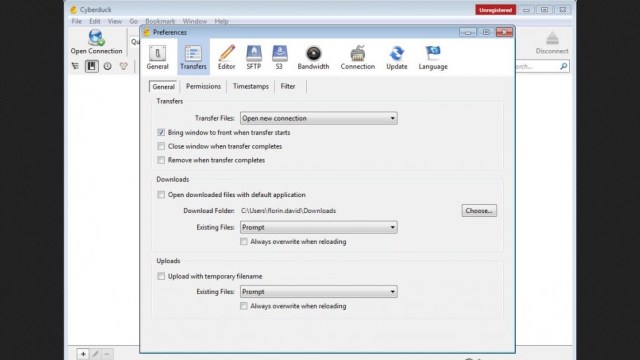

However, this can go higher if you have overclocked it.
#How to use cyberduck pc windows#
Windows Task Manager is an effective way to check your memory type, usage, speed, and many other properties. Thus, in this section, we have included five simple ways of checking it on Windows. Since DDR type helps determine the data rate, transfer rate, voltage capacity, throughput, and other essential information of your memory, you should definitely know the type of DDR you’re using. Thus, it’s good if you’re aware of your RAM details. Undoubtedly, RAM is one of the most critical components of our computer system. This is because you can’t use a lower generation DDR, like DDR3, on the DDR4 or DDR5 RAM slot due to backward incompatibility. Moreover, knowing what RAM is compatible with your motherboard is quite essential. On the other hand, DDR utilizes both the falling and rising edges in the same clock cycle thus, the transfer rate doubles. Firstly, SDR measures just the rising edge of the signal, which means the data transfer is done just once in a clock cycle. To understand this, let’s take an example from the above illustration. Basically, DDR is an upgraded version of SDR (Single Data Rate) where the data transfer occurs in a single clock cycle. This WebLearn Overview page lists the most common uses of WebLearn, with suggested alternatives.DDR SDRAM stands for Double Data Rate Synchronous Dynamic Random Access Memory, and it is the memory type that transfers data twice at the same time an SDRAM could do. This depends on what you are using WebLearn for. If you have any questions about alternatives to WebLearn or if the withdrawal of these facilities presents a significant problem for you, please get in touch via email.

In addition, WebLearn can now only be used from within the University network.Īnybody attempting to access WebLearn from a non-Oxford University IP address will see a 'guidance page' containing It is no longer possible to upload or create documents: 'write access' to Resources and Drop Box has been withdrawn. If you are currently using WebLearn for any on-going activities, you must move this activity to an alternative platform immediately. WebLearn is now closed for general use - the service will be withdrawn during 2023.
#How to use cyberduck pc update#
WebLearn decommissioning update - October 2022 Once you are connected to VPN, this link to OXAM will work. Email: still resides in WebLearn so, as you are not within the University network, you will need to use the University's Virtual private network (VPN) service Students: if you arrived at this page after clicking a link on a College or Departmental web page then please let us know the URL of the page containing the link so that we can ask for the page to be updated.


WebLearn is now only accessible from within the University network


 0 kommentar(er)
0 kommentar(er)
